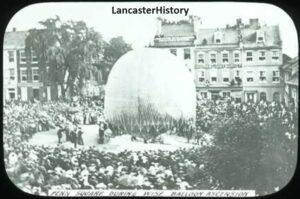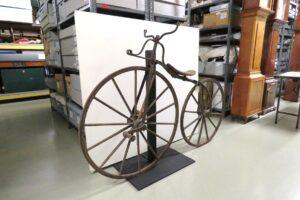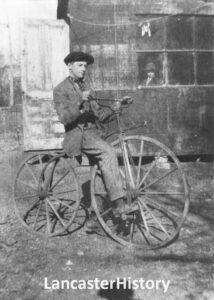Restoring John Wise’s Velocipede
Contributed and Written by James McMahon and Andre Dominguez
A New Object for Ware Commons
LancasterHistory is pleased to announce that a nineteenth century velocipede built and operated by celebrated Lancaster balloonist John Wise will soon join President James Buchanan’s 1853 Rockaway Carriage on the mezzanine of Ware Commons. The two-wheeled velocipede and four-wheeled carriage represent two modes of nineteenth-century transportation utilized by individuals in the age before the invention of the automobile.
A velocipede is a human-powered land vehicle with one or more wheels. The bicycle is one of the most common type of velocipede. Early version of the bicycle featured a larger front wheel which improved efficiency by increasing the distance covered for each turn of the pedals. Over time, the front wheel became even larger, earning these cycles the nickname penny-farthing; a reference to the smallest and largest British coins in circulation at the time. Its iron-and-wood construction and lack of springs, coupled with the rough condition of many roads, earned the velocipede the well-earned nickname of “boneshaker.” Without brakes and without a chain, riding a velocipede took a great deal of strength, coordination, and daring!
John Wise – Aeronautical Pioneer

Pioneering balloonist John Wise was by nature an inquisitive and adventurous man. Born in Lancaster on February 24, 1808, John Wise made his first balloon ascension in 1835 from Philadelphia. Often referred to as the “Father of American Ballooning,” Wise made 462 balloon ascensions, including a number from various locations in Lancaster. During these voyages, Wise conducted a number of scientific investigations and observations. In 1842, Wise was the first to observe what we today call the jet stream, the large body of fast moving air at a high altitude moving from west to

east. As an inventor, Wise also developed an early ripcord parachute safety mechanism.
John Wise also believed that ballooning could be used as a practical way to transport both people and goods. In 1843 he approached Congress for an appropriation to study the idea of using the jet stream to carry people across the country and eventually over the Atlantic Ocean. In 1859, he used his balloon to transport mail for the U.S. Postal Service. During the Mexican War and the U.S. Civil War, Wise advocated for the use of balloons in reconnaissance and surveillance.
The Death of John Wise

”This flag has accompanied 239 aerial voyages – has travelled in the air over 11,000 miles – has been constantly the harbinger of good fortune and no serious accident ever occurred while it was present. It is a talisman of good luck. It is over 34 years old and was made in 1834.” LancasterHistory
Wise’s fearlessness in the air appears to have fueled a similar daring on the ground. By the mid-1860s, Americans in general – and John Wise in particular – began to show an immense enthusiasm for the new two-wheeled mode of transportation known as the velocipede. At the same time, Wise continued his exploits in the air. In 1873, he authored a book titled Through the Air that included detailed descriptions of his aeronautical experiences and experiments. His last ascent took place on September 29, 1879. Departing from St. Louis, Missouri, Wise and a passenger named George Burr were last seen flying over Lake Michigan. Although Burr’s body was later recovered, Wise, age 71, and his balloon were never found.
Remembering John Wise
A bronze plaque placed by the Lancaster County Historical Society (now LancasterHistory) in Musser Park near the site of Wise’s Lancaster home pays mute testimony to his aeronautic accomplishments. Topped with a round balloon, the plaque reads:
Monument to John Wise
Famous pioneer aeronaut of America who was born in Lancaster in 1808 and lived most of his life near this spot. Beginning in 1835 he completed, from many towns, 462 balloon accessions during his lifetime. John Wise lies in Lake Michigan where his balloon fell after an ascent from St. Louis September 29, 1879.
Preparing the Velocipede for Exhibit
Based on the photograph of Raymond Franklin Bitner on the velocipede at or around the time of its donation to the Lancaster County Historical Society in 1916, it appears that the velocipede was complete. At some point during the next 100 plus years, the handlebar and hand grips disappeared and the wooden seat was damaged. To prepare the object for exhibition, museum staff decided to replace the missing handlebar and hand grips. Because the seat was for the most part intact, staff decided to leave that part of the object as is.
Using the 1916 photograph as a point of departure, museum volunteer Andre Dominguez contacted Trek Bicycle Lancaster in Rohrerstown for advice on how best to replace the missing components. Trek Bicycle put the museum in touch with Todd Boyer, local fabricator and velocipede expert from Manchester, Pennsylvania. Todd was only too glad to volunteer his time to research what was needed and fabricate the handle bar and grips.
Using photographs of other existing velocipedes and the patent drawings, Todd was able to replicate the bar and then, using a lathe, turn a wood piece into authentic looking handle grips. It was important that the handle bar fit the existing holes of the bar brace and that it looked the age of the velocipede. For this Todd located the proper diameter bar in a salvage yard that had been outside in the elements for years. Todd then used a piece of maple he already had in his inventory to fashion the grips. The grips had to be stained to look the same age as the velocipede. Todd cleaned the dirt and grim from the bar and then used the black waste liquid to stain the grips. It was perfect!
As mentioned previously, the velocipede will soon be placed on the mezzanine in Ware Commons alongside President James Buchanan’s Carriage. Keep your eyes peeled for this restored and fascinating piece of Lancaster County transportation history!
From Object Lessons








